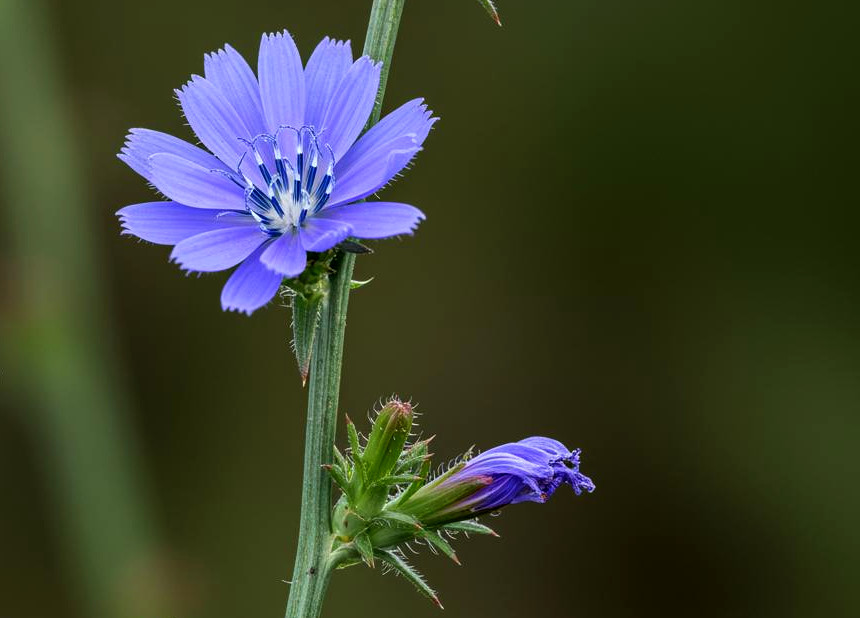Wise Mind Herbs
Evidence-based Herbal Healing
The information on this page has been prepared with reference to published scientific literature, not by a medically qualified expert. It is not medical advice. Any decision to use a supplement or herb-based product is your responsibility. Consult a suitably qualified medical professional, especially if you have underlying conditions. Remember, nothing is for everyone, and not everything sold is what it claims to be. Some things work for some people, some of the time.
Chicory (Cichorium intybus)
Chicory (Cichorium intybus L.) is a perennial herbaceous plant belonging to the Asteraceae family. It has been used traditionally in various cultures for its potential medicinal properties. This review summarizes the current scientific understanding of chicory's health benefits based on peer-reviewed literature.

Common and Botanical Names
Chicory is scientifically known as Cichorium intybus L. Common names include: common chicory, blue daisy, blue dandelion, blue sailors, blue weed, coffeeweed, succory, and wild endive. It should not be confused with endive (Cichorium endivia), which is a closely related but distinct species often used as a salad green. Additionally, radicchio and Belgian endive are cultivated varieties of Cichorium intybus rather than separate species.
Bioactive Compounds
Chicory contains several bioactive compounds that contribute to its potential health benefits. These include inulin (a type of soluble fiber), sesquiterpene lactones, flavonoids, caffeoylquinic acids, coumarins, and various phenolic compounds. The root typically contains 15-20% inulin and 5-10% oligofructose by fresh weight, while leaves contain higher concentrations of polyphenols and sesquiterpene lactones.
Evidence-Based Health Benefits
- Prebiotic Effects: Strong evidence supports chicory root's inulin and oligofructose as prebiotics that stimulate the growth of beneficial gut bacteria, particularly Bifidobacteria and Lactobacilli.
- Digestive Health: Moderate evidence indicates benefits for constipation relief, improved stool consistency, and increased fecal bulk due to its fiber content.
- Glycemic Control: Several clinical trials suggest modest improvements in insulin sensitivity and glucose metabolism in individuals with type 2 diabetes or prediabetes.
- Lipid Profile Management: Limited evidence indicates potential for modest reductions in total cholesterol and triglycerides.
- Anti-inflammatory Effects: Preclinical studies show promising anti-inflammatory activity, but human clinical evidence remains preliminary.
- Hepatoprotective Properties: Animal studies suggest liver-protective effects, with limited human evidence.
- Antimicrobial Activity: In vitro studies demonstrate antimicrobial effects against certain pathogens.
Conditions with Preliminary Evidence of Benefit
- Irritable Bowel Syndrome (IBS): Limited evidence for symptom improvement, particularly constipation-predominant IBS.
- Non-alcoholic Fatty Liver Disease: Emerging evidence from small clinical trials.
- Inflammatory Bowel Disease: Preliminary evidence for potential benefits in reducing inflammation.
- Dyslipidemia: Limited evidence for modest improvements in lipid profiles.
- Obesity: Some evidence suggests benefits for weight management through improved satiety and gut microbiota modulation.
Recommended Dosages
Clinical studies have used varying dosages depending on the preparation and intended effect:
- Inulin/Oligofructose: 5-20g daily for prebiotic effects. Most studies show optimal effects at 8-10g daily.
- Chicory Root Extract: 300-600mg daily (standardized to contain 45-55% inulin).
- Chicory Root Coffee Substitute: 2-4 cups daily (approximately 2-3g of roasted root per cup).
- Chicory Leaf Extract: 200-400mg daily (standardized to contain 3-5% total phenolic compounds).
Standardization varies considerably between preparations. Most commercial products standardize based on inulin content for root extracts or total phenolic content for leaf extracts, but there is no universal standard.
Side Effects and Safety Concerns
- Gastrointestinal Distress: Common side effects include bloating, flatulence, abdominal discomfort, and diarrhea, particularly when starting supplementation or at higher doses.
- Allergic Reactions: Individuals with allergies to plants in the Asteraceae family (including ragweed, chrysanthemums, marigolds, daisies) may experience allergic reactions.
- Bile Duct Stimulation: May exacerbate symptoms in individuals with gallstones or bile duct obstruction.
- Pregnancy and Lactation: Insufficient safety data for medicinal doses during pregnancy or breastfeeding.
- Drug Interactions: Theoretical potential for interactions with medications metabolized by cytochrome P450 enzymes, though clinical significance is unclear.
Studies on Dosages Above Recommended Ranges
Limited systematic research exists on doses significantly exceeding the recommended ranges. The few available studies suggest:
- Doses of inulin/oligofructose exceeding 20g daily are associated with increased gastrointestinal side effects without proportional increases in benefits.
- No clear toxicity threshold has been established for chicory extracts in humans.
- Animal toxicity studies using concentrated extracts at doses equivalent to several times human therapeutic doses have not demonstrated significant toxicity beyond gastrointestinal effects.
This represents a significant knowledge gap in the literature. Most safety data comes from traditional use patterns rather than systematic dose-escalation studies.
Conclusion
Chicory shows promising health benefits primarily related to its prebiotic effects and digestive health support. The strongest evidence exists for its effects on gut microbiota and mild laxative properties. Other potential benefits, including anti-inflammatory, hepatoprotective, and metabolic effects, have emerging but less established evidence. Safety is generally good at recommended doses, with gastrointestinal effects being the most common side effects. Significant knowledge gaps exist regarding optimal dosing, standardization, and effects of long-term use.
References
Ahmed, W., & Rashid, S. (2019). Functional and therapeutic potential of inulin: A comprehensive review. Critical reviews in food science and nutrition, 59(1), 1-13.
Aisa, H. A., Xin, X. L., & Tang, D. (2020). Chemical constituents and their pharmacological activities of plants from Cichorium genus. Chinese Herbal Medicines, 12(3), 224-236.
Birsa, M. L., & Sarbu, L. G. (2023). Health Benefits of Key Constituents in Cichorium intybus L. Nutrients, 15(6), 1322.
Franco-Robles, E., & López, M. G. (2015). Implication of fructans in health: immunomodulatory and antioxidant mechanisms. The Scientific World Journal, 2015(1), 289267.
Li, D., Kim, J.M., Jin, Z. and Zhou, J., 2020. Prebiotic effectiveness of inulin extracted from edible burdock (Arctium lappa L.). Anaerobe, 55, pp.119-125.
Nishimura, M., Ohkawara, T., Kanayama, T., Kitagawa, K., Nishimura, H., & Nishihira, J. (2015). Effects of the extract from roasted chicory (Cichorium intybus L.) root containing inulin-type fructans on blood glucose, lipid metabolism, and fecal properties. Journal of traditional and complementary medicine, 5(3), 161.